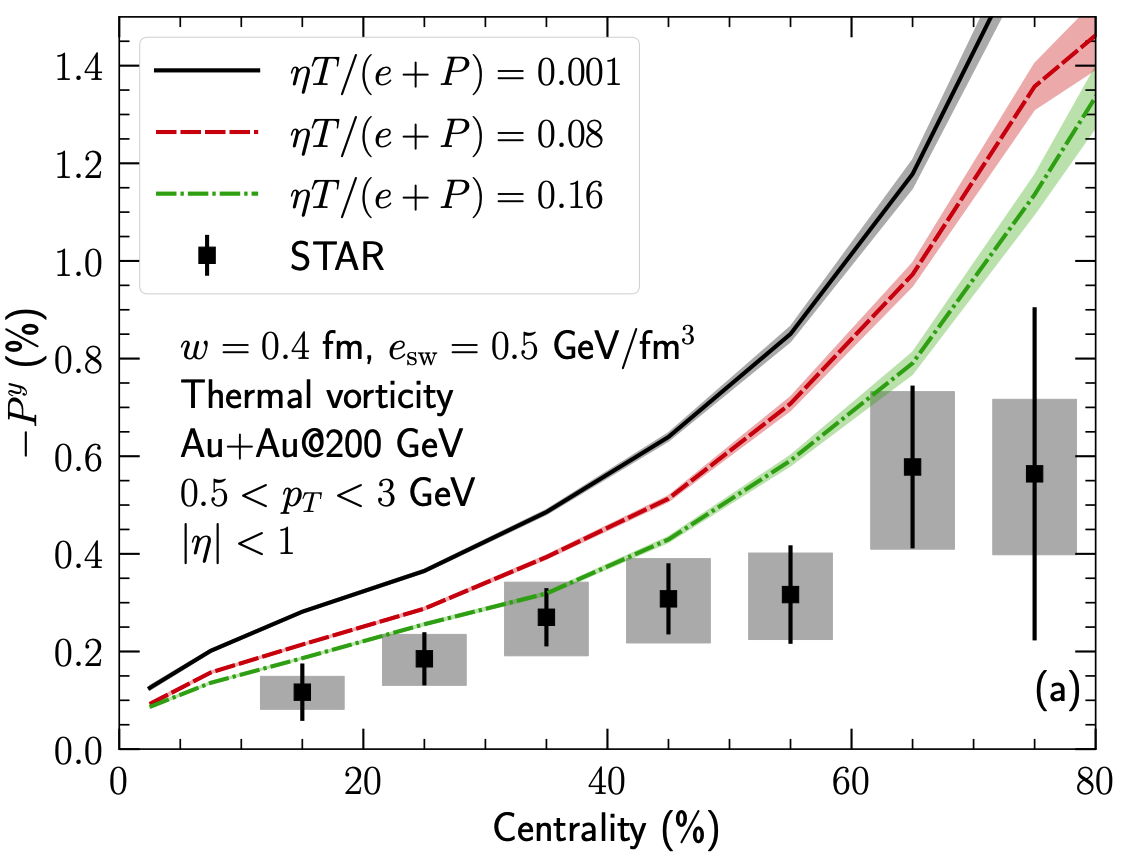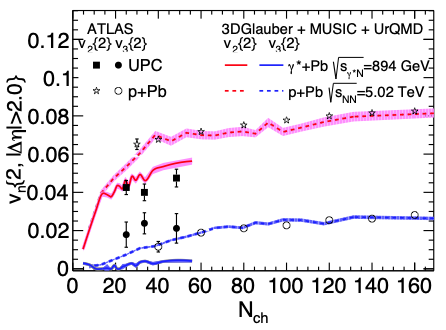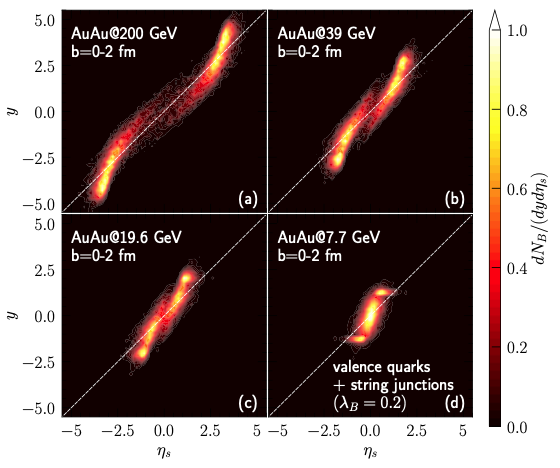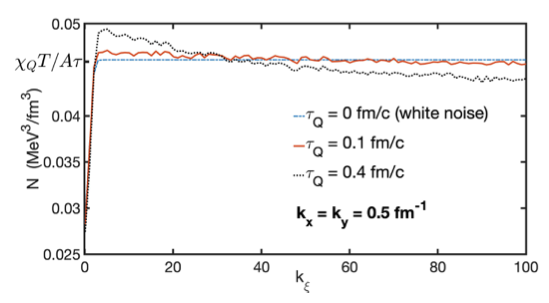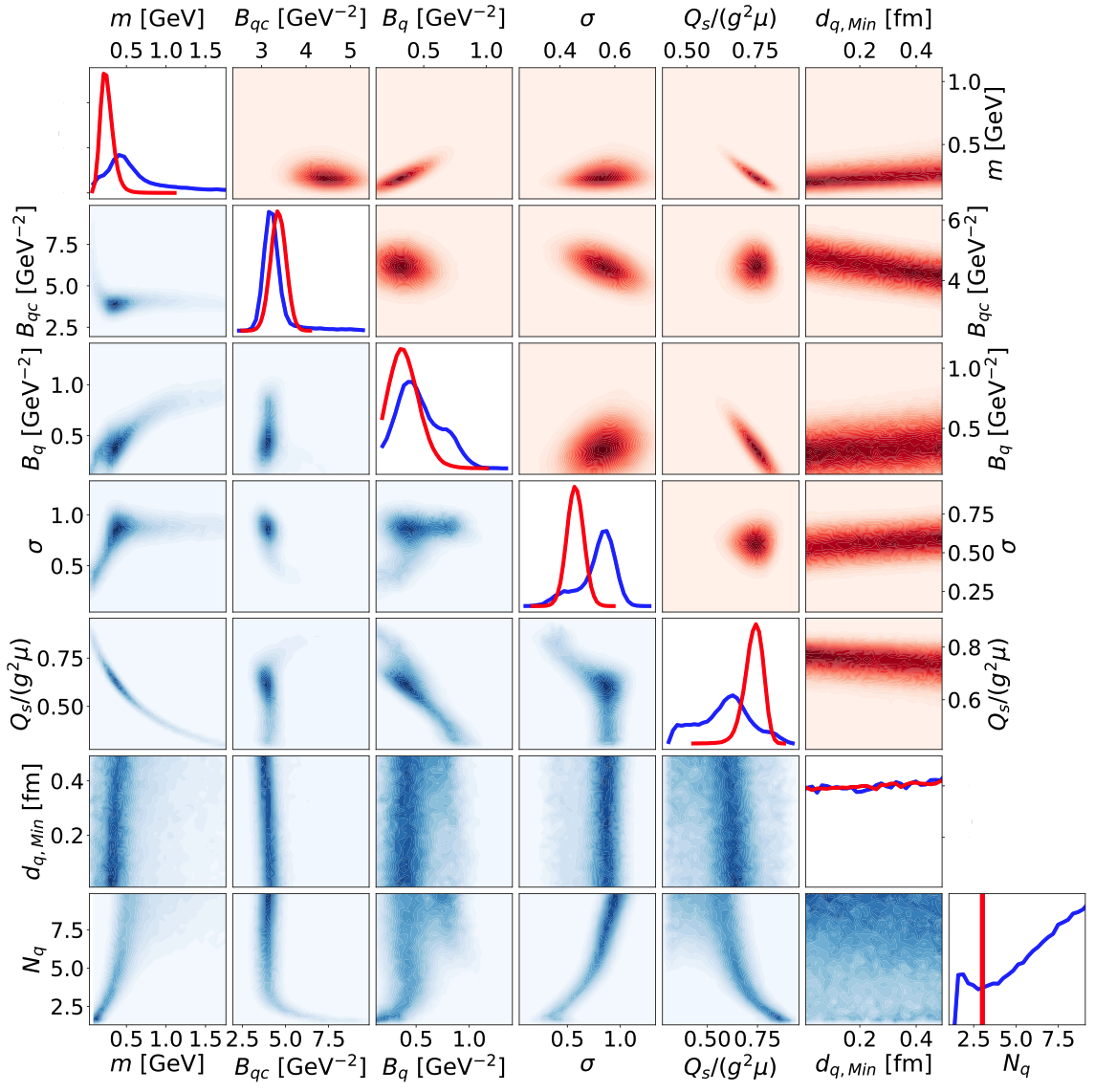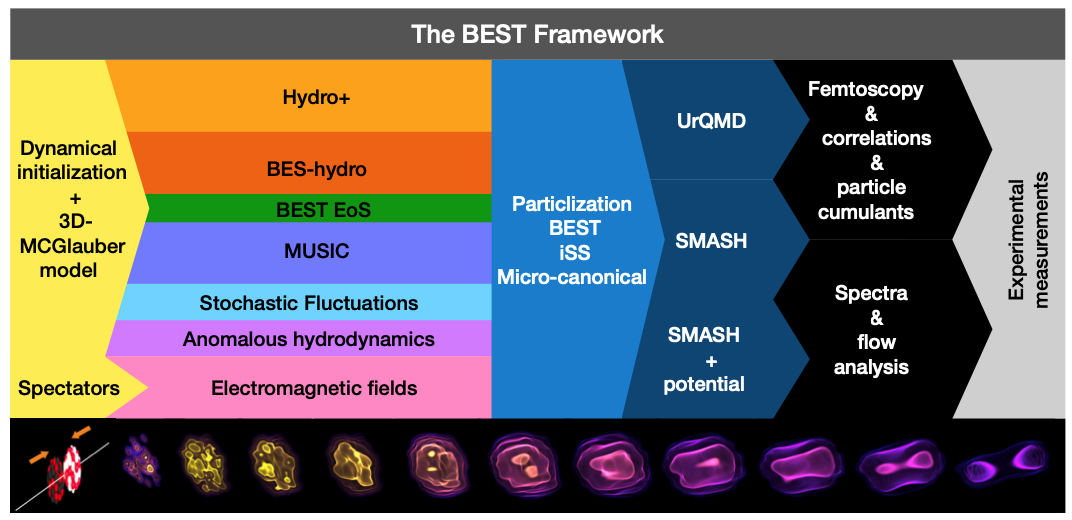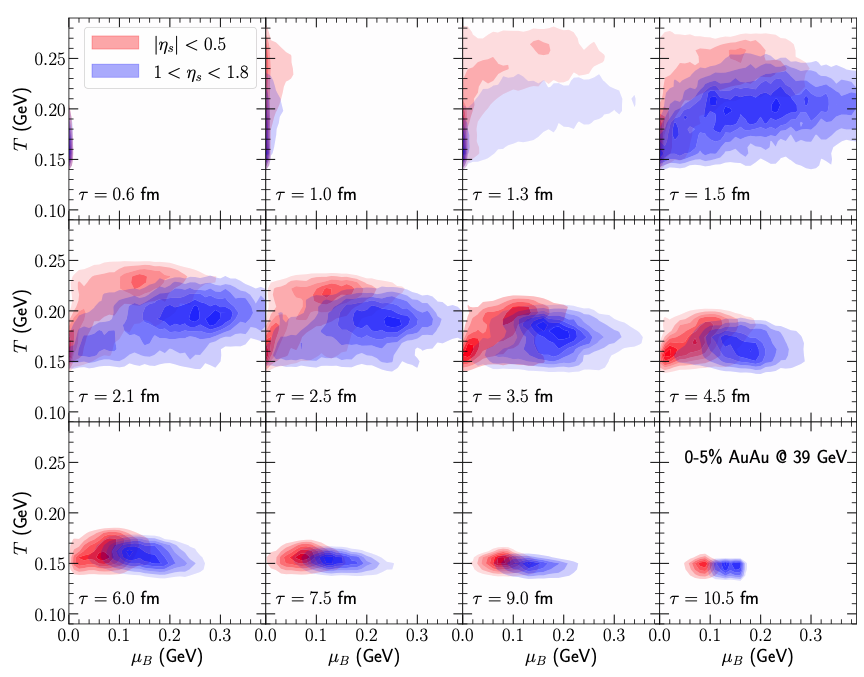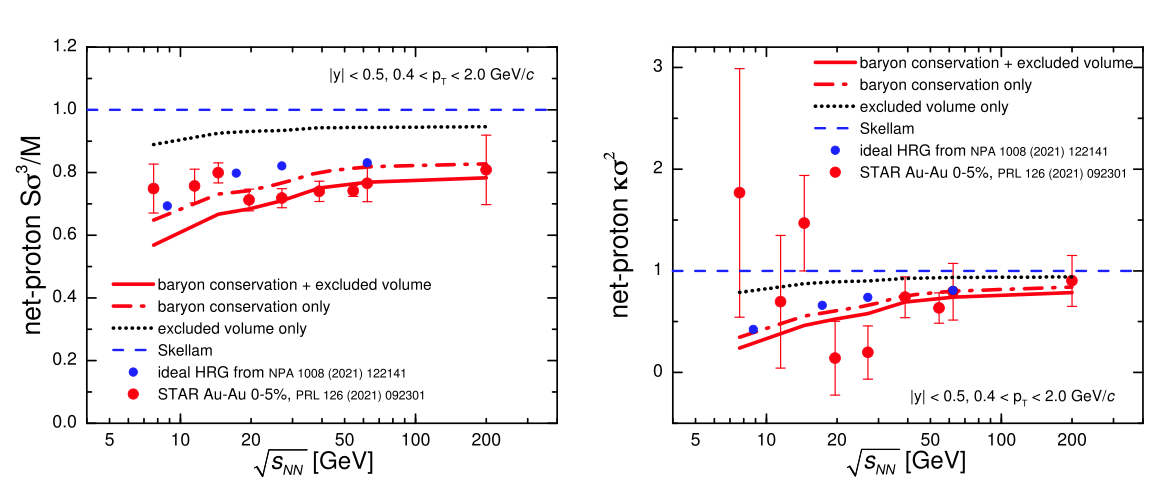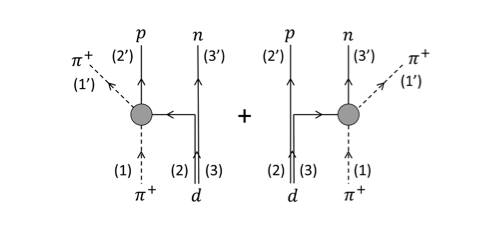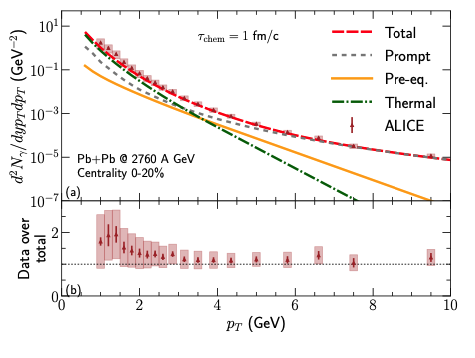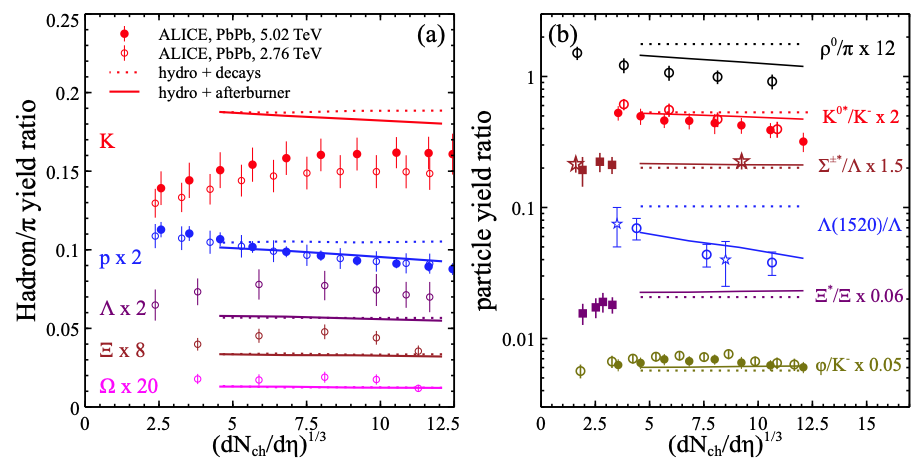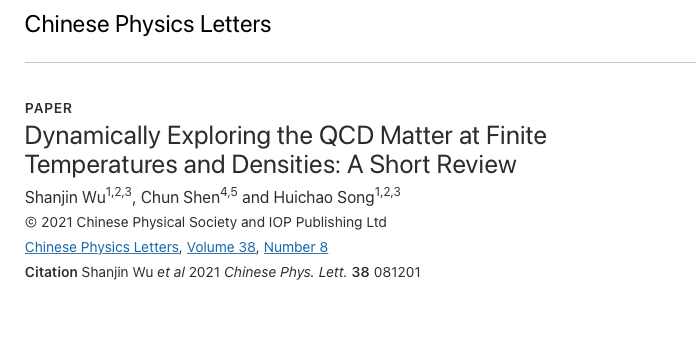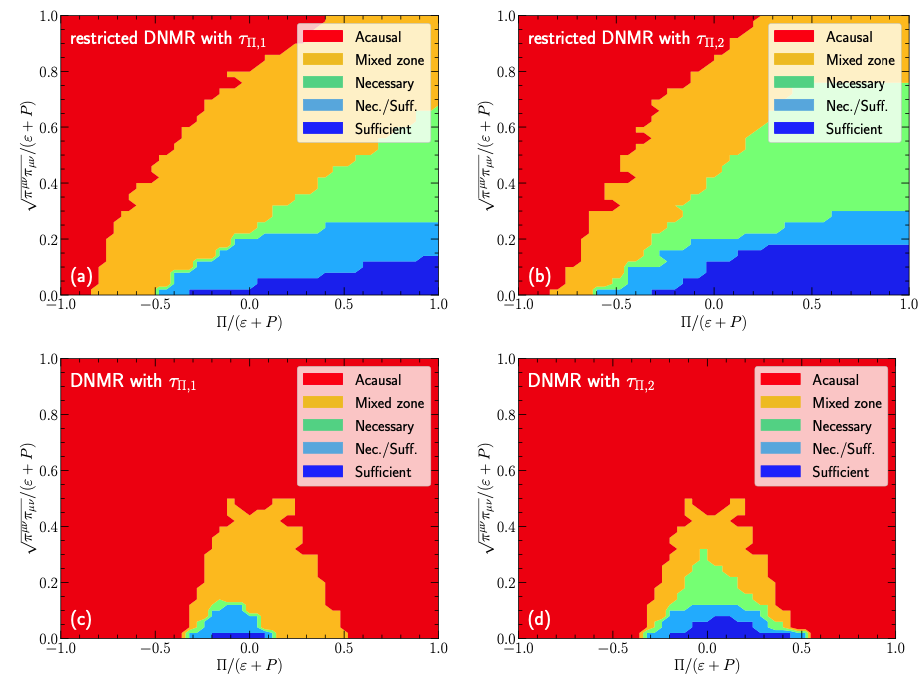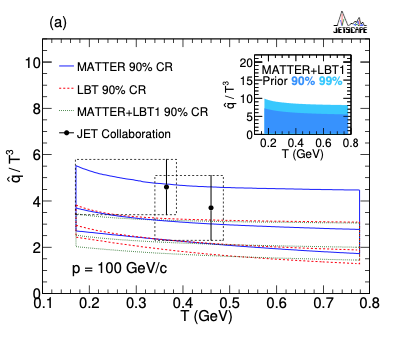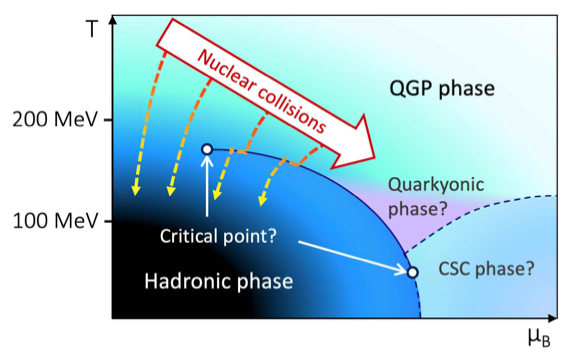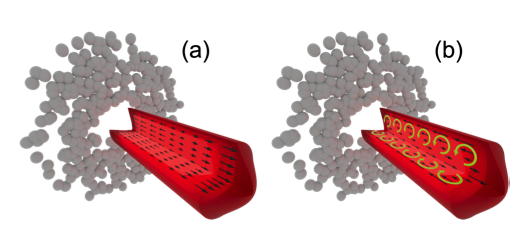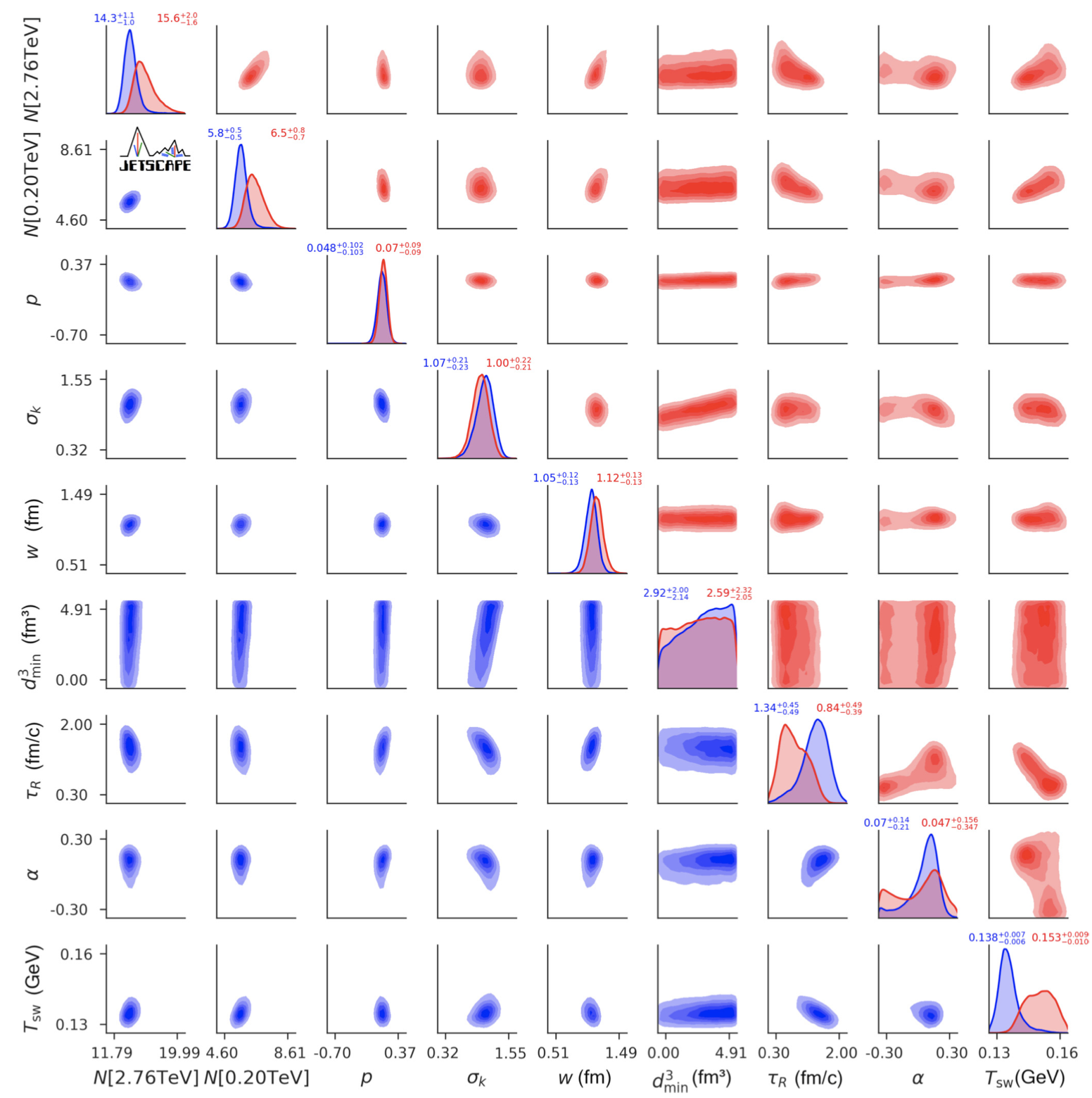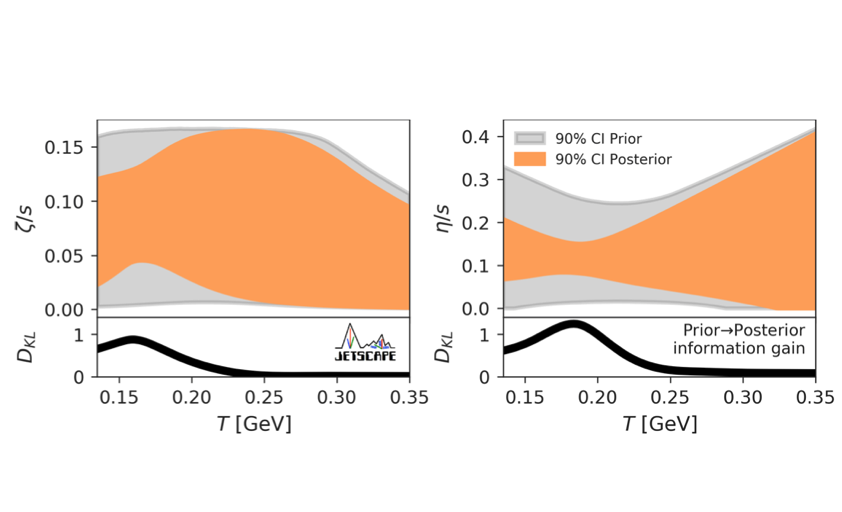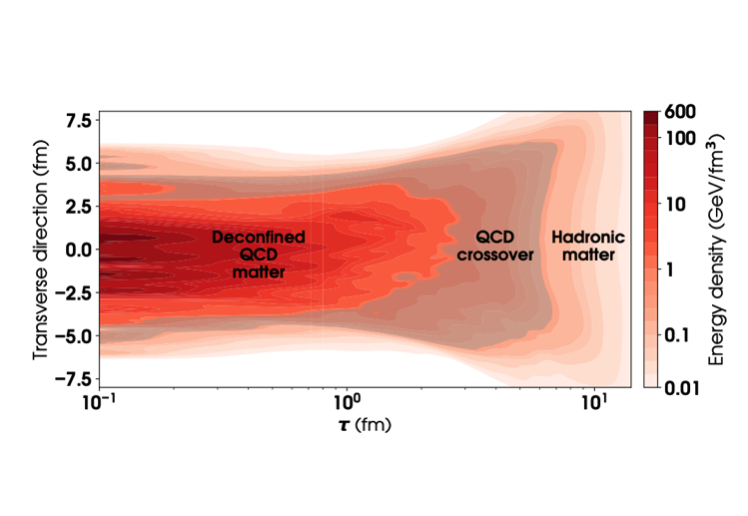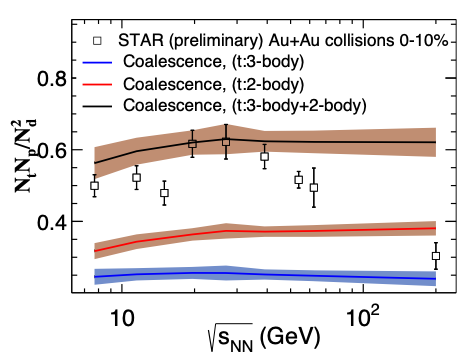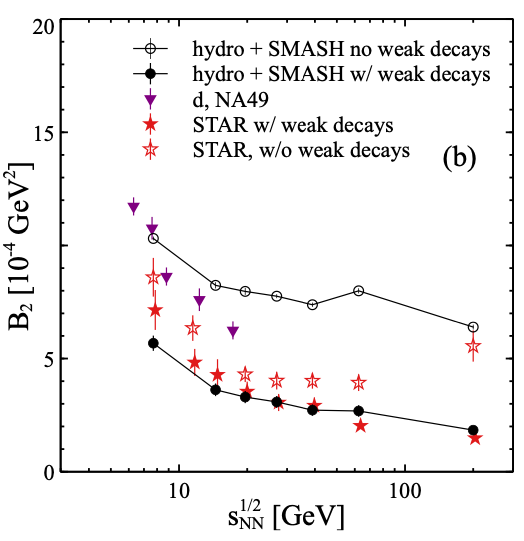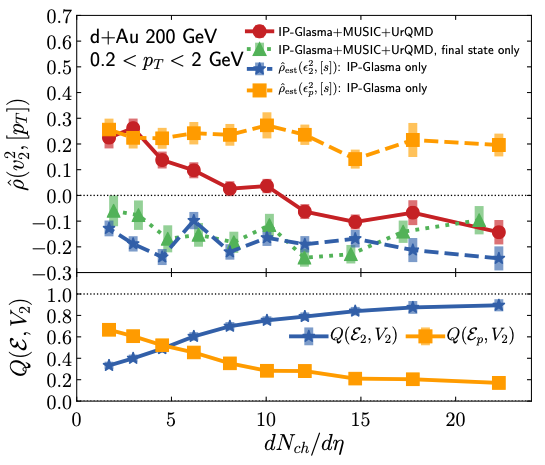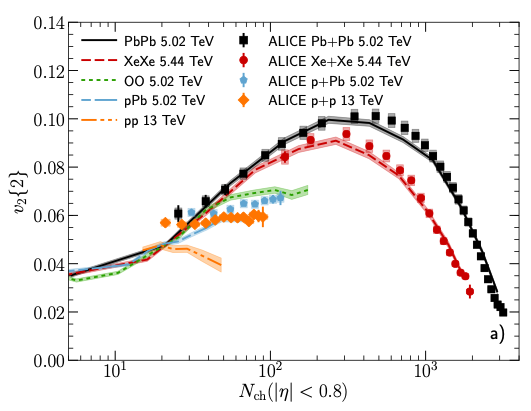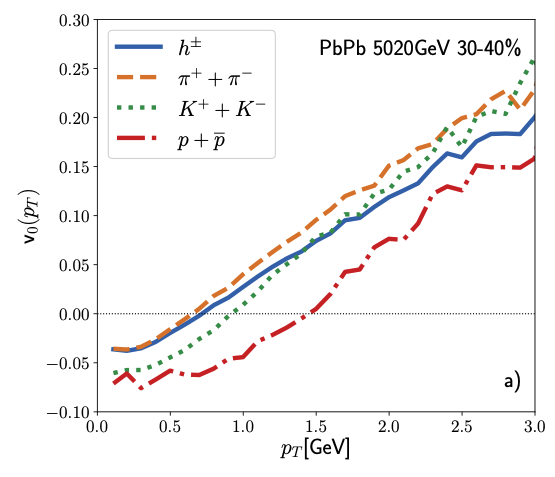Papers and Conference Proceedings
Mar. 2022: Λ spin polarization in event-by-event relativistic heavy-ion collisions
Sahr Alzhrani, Sangwook Ryu, and Chun Shen
We present a systematic study of Λ hyperon's polarization observables using event-by-event (3+1)D relativistic hydrodynamics. The effects of initial hot spot size and QGP's specific shear viscosity on the polarization observables are quantified. We examine the effects of the two formulations of the thermal shear tensor on the polarization observables using the same hydrodynamic background. With event-by-event simulations, we make predictions for the Fourier coefficients of Λ's longitudinal polarization P^z with respect to the event planes of different orders of anisotropic flow. We propose new correlations among the Fourier coefficients of P^z and charged hadron anisotropic flow coefficients to further test the mapping from fluid velocity gradients to hyperon's polarization. Finally, we present a system size scan with Au+Au, Ru+Ru, and O+O collisions at √s_{NN} = 200 GeV to study the system size dependence of polarization observables at the Relativistic Heavy-ion Collider.
e-PrintMar. 2022: Collectivity in Ultra-Peripheral Pb+Pb Collisions at the Large Hadron Collider
Wenbin Zhao, Chun Shen, and Bjorn Schenke
We present the first full (3+1)D dynamical simulations of ultra-peripheral Pb+Pb collisions at the Large Hadron Collider. Extrapolating from p+Pb collisions, we explore whether a quasi-real photon γ^* interacting with the lead nucleus in an ultra-peripheral collision can create a many- body system exhibiting fluid behavior. Assuming strong final-state interactions, we provide model results for charged hadron multiplicity, identified particle mean transverse momenta, and charged hadron anisotropic flow coefficients, and compare them with experimental data from the ALICE and ATLAS collaborations. The elliptic flow hierarchy between p+Pb and γ^∗+Pb collisions is dominated by the difference in longitudinal flow decorrelations and reproduces the experimental data well. We have demonstrated that our theoretical framework provides a quantitative tool to study particle production and collectivity for all system sizes, ranging from central heavy-ion collisions to small asymmetric collision systems at the Relativistic Heavy-Ion Collider and the Large Hadron Collider and even at the future Electron-Ion Collider.
e-PrintMar. 2022: Longitudinal dynamics and particle production in relativistic nuclear collisions
C. Shen and B. Schenke
This work presents a three-dimensional dynamical initialization model for relativistic heavy-ion collisions, implementing local energy-momentum conservation and baryon charge fluctuations at string junctions. Constraining parameters using experimental data from p+p collisions at various collision energies, the model provides a very good description of the charged hadron and net proton rapidity distributions in Au+Au collisions from 7.7 to 200 GeV and Pb+Pb collisions at 8.77 and 17.3 GeV. We demonstrate the importance of fluctuations of baryon densities to string junctions for describing net-proton distributions at collision energies of 62.4 and 200 GeV. Including this improved baryon stopping description along with the requirement of strangeness neutrality also yields a good description of identified particle yields as functions of the collision energy above 7.7 GeV. We further study asymmetric p+Al and (p, d, 3He)+Au collisions at the top RHIC energy and p+Pb, Xe+Xe, and Pb+Pb collisions at LHC energies. We identify the produced particle rapidity distributions in asymmetric collision systems as particularly useful for constraining models of the early-time longitudinal dynamics.
e-PrintMar. 2022: Stochastic hydrodynamics meets hydro-kinetics
A. De, C. Shen and J. Kapusta
The hydro-kinetic formalism has been used as a complementary approach to solving the Stochastic Differential Equations (SDE) corresponding to noisy hydrodynamics. The hydro-kinetic formalism consists of a deterministic set of relaxation type equations that tracks the evolution of 2-point correlation functions of stochastic hydrodynamic quantities. Hence they are comparatively easier to solve than the SDEs, which are computationally intensive and need to deal with arbitrarily large gradients. This work compares the two approaches for the propagation and diffusion of conserved charge fluctuations in the Bjorken hydrodynamic model. For white noise, the two approaches agree. For colored Catteneo noise, which is causal, the two approaches diverge. This is because white noise only induces two-point correlations, while Catteneo noise also induces higher-order correlations. This difference is quantified from the effects of causal evolution and influence from higher-order correlations induced by the Catteneo noise.
e-PrintFeb. 2022: Bayesian inference of the fluctuating proton shape
H. Mantysaari, B. Schenke, C. Shen and W. Zhao
Using Bayesian inference, we determine probabilistic constraints on the parameters describing the fluctuating structure of protons at high energy. We employ the color glass condensate framework supplemented with a model for the spatial structure of the proton, along with experimental data from the ZEUS and H1 Collaborations on coherent and incoherent diffractive J/ψ production in e+p collisions at HERA. This data is found to constrain most model parameters well. This work sets the stage for future global analyses, including experimental data from e+p, p+p, and p+A collisions, to constrain the fluctuating structure of nucleons along with properties of the final state.
e-PrintNov. 2021: Constraining the Nucleon Size with Relativistic Nuclear Collisions
G. Giacalone, B. Schenke and C. Shen
The notion of the “size” of nucleons and their constituents plays a pivotal role in the current paradigm of the formation and the fluctuations of the quark-gluon plasma produced in high-energy nuclear collision experiments. We report on state-of-the-art hydrodynamic results showing that the correlation between anisotropic flow, v_n{2}, and the mean transverse momentum of hadrons, [pt], possesses a unique sensitivity to the nucleon size in off-central heavy-ion collisions. We argue that existing experimental measurements of this observable support a picture where the relevant length scale characterizing the colliding nucleons is of order 0.5 fm or smaller, and we discuss the broad implications of this finding for future global Bayesian analyses aimed at extracting initial- state and medium properties from nucleus-nucleus collision data, including vn2-[pt] correlations. Determinations of the nucleon size in heavy-ion collisions will provide a solid independent constraint on the initial state of small system collisions, and will establish a deep connection between collective flow data in nucleus-nucleus experiments and data on deep inelastic scattering on protons and nuclei.
e-Print Published in Phys. Rev. Lett.Aug. 2021: The BEST framework for the search for the QCD critical point and the chiral magnetic effect
BEST Collaboration
The Beam Energy Scan Theory (BEST) Collaboration was formed with the goal of providing a theoretical framework for analyzing data from the Beam Energy Scan (BES) program at the relativistic heavy ion collider (RHIC) at Brookhaven National Laboratory. The physics goal of the BES program is the search for a conjectured QCD critical point as well as for manifestations of the chiral magnetic effect. We describe progress that has been made over the previous five years. This includes studies of the equation of state and equilibrium susceptibilities, the development of suitable initial state models, progress in constructing a hydrodynamic framework that includes fluctuations and anomalous transport effects, as well as the development of freezeout prescriptions and hadronic transport models. Finally, we address the challenge of integrating these components into a complete analysis framework. This document describes the collective effort of the BEST Collaboration and its collaborators around the world.
e-Print Published in Nucl. Phys. AAug. 2021: Dynamic modeling for heavy-ion collisions
Chun Shen
Recent theory progress in (3+1)D dynamical descriptions of rela- tivistic nuclear collisions at finite baryon density are reviewed. Heavy-ion collisions at different collision energies produce strongly coupled nuclear matter to probe the phase structure of Quantum Chromodynamics (QCD). Dynamical frameworks serve as a quantitative tool to study properties of hot QCD matter and map collisions to the QCD phase diagram. Outstanding challenges are highlighted when confronting theoretical models with the current and forthcoming experimental measurements from the RHIC beam energy scan program.
e-Print SQM Proceeding published in EPJ Web Conf.July 2021: Proton number cumulants and correlation functions in Au-Au collisions at sNN=7.7–200 GeV from hydrodynamics
V. Vovchenko, V. Koch and C. Shen
We present a dynamical description of (anti)proton number cumulants and correlation functions in central Au-Au collisions at √sNN = 7.7 − 200 GeV by utilizing viscous hydrodynamics simulations. The cumulants of proton and baryon number are calculated in a given momentum acceptance analytically, via an appropriately extended Cooper-Frye procedure describing particlization of an interacting hadron resonance gas. The effects of global baryon number conservation are taken into account using a generalized subensemble acceptance method. The experimental data of the STAR Collaboration are consistent at √sNN > 20 GeV with simultaneous effects of global baryon number conservation and repulsive interactions in baryon sector, the latter being in line with the behavior of baryon number susceptibilities observed in lattice QCD. The data at lower collision energies show possible indications for sizable attractive interactions among baryons. The data also indicate sizable negative two-particle correlations between antiprotons that are not satisfactorily described by baryon conservation and excluded volume effects. We also discuss differences between cumulants and correlation functions (factorial cumulants) of (anti)proton number distribution, proton versus baryon number fluctuations, and effects of hadronic afterburner.
e-Print Published in Phys. Rev. CJune 2021: Relativistic kinetic approach to light nuclei production in high-energy nuclear collisions
K. J. Sun, R. Wang, C. M. Ko, Y. G. Ma and C. Shen
Understanding the production mechanism of light (anti-)nuclei in high-energy nuclear collisions and cosmic rays has been a long-standing problem in nuclear physics. In the present study, we develop a stochastic method to solve the relativistic kinetic equations for light nuclei production from many-body reactions with the inclusion of their finite sizes. The present approach gives an excellent description of the deuteron and helium-3 data from central Au+Au (Pb+Pb) collisions at sqrt{sNN} = 200 GeV (2.76 TeV). It can also naturally explain their suppressed production in pp collisions at 7 TeV as a result of their finite sizes.
e-PrintJune 2021: Multimessenger heavy-ion collision physics
C. Gale, J. F. Paquet, B. Schenke and C. Shen
This work studies the production of direct photons in relativistic nuclear collisions, along with the production of hadrons. Radiation from the very first instants to the final moments of the evolution is included. The hybrid model used here describes all stages of relativistic heavy-ion collisions. Chronologically, those are an initial state reflecting the collision of nuclei described within the Color Glass Condensate effective theory; a pre-equilibrium phase based on non-equilibrium linear response; relativistic viscous hydrodynamics, and a hadronic afterburner. The effect of the pre- equilibrium phase on both photonic and hadronic observables is highlighted for the first time. The potential of photon observables – spectrum, differential elliptic and triangular flow – to reveal the chemical equilibration time is studied. Finally, we consider “small collision systems”, including proton+nucleus collisions and collisions of light nuclei, as probed by hadronic and electromagnetic observables. We demonstrate how photon production can signal the formation of quark-gluon plasma in such small systems.
e-Print Published in Phys. Rev. CJune 2021: Probing early-time longitudinal dynamics with the Λ hyperon's spin polarization in relativistic heavy-ion collisions
S. Ryu, V. Jupic and C. Shen
We systematically study the hyperon global polarization’s sensitivity to the collision systems’ initial longitudinal flow velocity in hydrodynamic simulations. By explicitly imposing local energy- momentum conservation when mapping the initial collision geometry to macroscopic hydrodynamic fields, we study the evolution of systems’ orbital angular momentum (OAM) and fluid vorticity. We find that a simultaneous description of the Λ hyperons’ global polarization and the slope of pion’s directed flow can strongly constrain the size of longitudinal flow at the beginning of hydrodynamic evolution. We extract the size of the initial longitudinal flow and the fraction of orbital angular momentum in the produced QGP fluid as a function of collision energy with the STAR measurements in the RHIC Beam Energy Scan program. We find that there is about 100-200 hbar OAM that remains in the mid-rapidity fluid at the beginning of hydrodynamic evolution. We further exam the effects of different hydrodynamic gradients on the spin polarization of Λ and Λbar. The gradients of μ_B/T can change the ordering between Λ’s and Λbar’s polarization.
e-Print Published in Phys. Rev. CMay 2021: Resonance production in PbPb collisions at 5.02 TeV via hydrodynamics and hadronic afterburner
D. Oliinychenko and C. Shen
Using a relativistic hydrodynamics + hadronic afterburner simulation we explore resonance pro- duction in PbPb collisions at 5.02 TeV, and demonstrate that many resonance yields, mean trans- verse momenta, and flows are very sensitive to the late stage hadronic rescattering. Out of all measured resonances Λ(1520) is affected strongest by the hadronic rescattering stage, which allows to estimate its duration, and even constrain branching ratios of Σ^* → Λ(1520)π decays. Strong sup- pression of Λ(1520), which in vacuum has a lifetime of 12.6 fm/c, is explained by its small lifetime in a hadronic medium, between 1 and 2 fm/c at temperatures between 100 and 150 MeV. We find that some resonances like ∆(1232), f0(980), a0(980), Λ(1405) are enhanced rather than suppressed by the afterburner.
e-PrintApr. 2021: Dynamically Exploring the QCD Matter at Finite Temperatures and Densities: A Short Review
S. Wu, C. Shen and H. Song
We show that an event-shape engineering based on the mean transverse momentum of charged hadrons, [pt], provides an optimal handle on the strength of the magnetic field created in central heavy-ion collisions at high energy. This is established through quantitative evaluations of the correlation existing between the event-by-event magnetic field produced by the spectator protons in 5.02 TeV Pb + Pb collisions and the event-by-event [pt] at a given collision centrality. We argue that the event selection based on [pt] provides a better handle on the magnetic field than the more traditional selection based on the event ellipticities. Advan- tages brought by this new method for the experimental search of the chiral magnetic effect are discussed.
e-Print Published in Chin. Phys. Lett.Apr. 2021: Manipulating strong electromagnetic fields with the average transverse momentum of relativistic nuclear collisions
G. Giacalone and C. Shen
We show that an event-shape engineering based on the mean transverse momentum of charged hadrons, [pt], provides an optimal handle on the strength of the magnetic field created in central heavy-ion collisions at high energy. This is established through quantitative evaluations of the correlation existing between the event-by-event magnetic field produced by the spectator protons in 5.02 TeV Pb + Pb collisions and the event-by-event [pt] at a given collision centrality. We argue that the event selection based on [pt] provides a better handle on the magnetic field than the more traditional selection based on the event ellipticities. Advan- tages brought by this new method for the experimental search of the chiral magnetic effect are discussed.
e-Print Published in EPJAMar. 2021: Exploring theoretical uncertainties in the hydrodynamic description of relativistic heavy-ion collisions
C. Chiu and C. Shen
We examine the formation of vortical “smoke rings” as a result of thermalization of energy lost by a jet. We simulate the formation and evolution of these rings using hydrodynamics and define an observable that allows to probe this phenomenon experimentally. We argue that observation of vorticity associated with jets would be an experimental confirmation of the thermalization of the energy lost by quenched jets, and also a probe of shear viscosity.
e-Print Published in Phys. Rev. CFeb. 2021: Λ polarization from thermalized jet energy
W. Serenone, J. Barbon, D. Chinellato, M. Lisa, C. Shen, J. Takahashi and G. Torrieri
We examine the formation of vortical “smoke rings” as a result of thermalization of energy lost by a jet. We simulate the formation and evolution of these rings using hydrodynamics and define an observable that allows to probe this phenomenon experimentally. We argue that observation of vorticity associated with jets would be an experimental confirmation of the thermalization of the energy lost by quenched jets, and also a probe of shear viscosity.
e-Print Published in Phys. Lett. BFeb. 2021: Determining the jet transport coefficient q̂ from inclusive hadron suppression measurements using Bayesian parameter estimation
JETSCAPE Collaboration
We report a new determination of qhat, the jet transport coefficient of the Quark-Gluon Plasma. We use the JETSCAPE framework, which incorporates a novel multi-stage theoretical approach to in-medium jet evolution and Bayesian inference for parameter extraction. The calculations, based on the Matter and LBT jet quenching models, are compared to experimental measurements of inclusive hadron suppression in Au+Au collisions at RHIC and Pb+Pb collisions at the LHC. The correlation of experimental systematic uncertainties is accounted for in the parameter extraction. The functional dependence of qhat on jet energy or virtuality and medium temperature is based on a perturbative picture of in-medium scattering, with components reflecting the different regimes of applicability of Matter and LBT. In the multi-stage approach, the switch between Matter and Lbt is governed by a virtuality scale Q_0. Comparison of the posterior model predictions to the RHIC and LHC hadron suppression data shows reasonable agreement, with moderate tension in limited regions of phase space. The distribution of qhat/T^3 extracted from the posterior distributions exhibits weak dependence on jet momentum and medium temperature T , with 90% Credible Region (CR) depending on the specific choice of model configuration. The choice of Matter+Lbt, with switching at virtuality Q_0, has 90% CR of 2 < qhat/T^3 < 4 for pT,jet > 40 GeV/c. The value of Q_0, determined here for the first time, is in the range 2.0-2.7 GeV.
e-Print Published in Phys. Rev. CJan. 2021: QCD Equation of State at Finite Chemical Potentials for Relativistic Nuclear Collisions
A. Monnai, B. Schenke and C. Shen
We review the equation of state of QCD matter at finite densities. We discuss the construction of the equation of state with net baryon number, electric charge, and strangeness using the results of lattice QCD simulations and hadron resonance gas mod- els. Its application to the hydrodynamic analyses of relativistic nuclear collisions suggests that the interplay of multiple conserved charges is important in the quantitative under- standing of the dense nuclear matter created at lower beam energies. Several different models of the QCD equation of state are discussed for comparison.
e-Print Invited review in IJMPAJan. 2021: Vortex rings from high energy central p+A collisions
M. Lisa, J. Barbon, D. Chinellato, W. Serenone, C. Shen, J. Takahashi and G. Torrieri
Relativistic p+A collisions may produce droplets of quark gluon plasma (QGP) that quickly develop a toroidal vortex structure similar to that of an expanding smoke ring. We present viscous relativistic hydrodynamic calculations of ultra-central p+A collisions and develop an experimental observable to probe the structure, correlating the polarization and momentum of hyperons emitted from the collision. This effect is robust against changes in the definition of vorticity used to calculate the polarization. Experiments at RHIC and LHC may test the existence and strength of the vortex toroids, bringing new evidence to bear on the question of collectivity in the smallest QGP droplets.
e-Print Published in Phys. Rev. C LetterNov. 2020: Multisystem Bayesian constraints on the transport coefficients of QCD matter
JETSCAPE Collaboration
We study the properties of the strongly coupled quark-gluon plasma with a multistage model of heavy-ion collisions that combines the TRENTo initial condition ansatz, free-streaming, viscous relativistic hydrodynamics, and a relativistic hadronic transport. A model-to-data comparison with Bayesian inference is performed, revisiting assumptions made in previous studies. The role of parameter priors is studied in light of their importance for the interpretation of results. We emphasize the use of closure tests to perform extensive validation of the analysis workflow before comparison with observations. Our study combines measurements from the Large Hadron Collider (LHC) and the Relativistic Heavy Ion Collider (RHIC), achieving a good simultaneous description of a wide range of hadronic observables from both colliders. The selected experimental data provide reasonable constraints on the shear and the bulk viscosities of the quark-gluon plasma at T ≈ 150–250 MeV, but their constraining power degrades at higher temperatures, T > 250 MeV. Furthermore, these viscosity constraints are found to depend significantly on how viscous corrections are handled in the transition from hydrodynamics to the hadronic transport. Several other model parameters, including the freestreaming time, show similar model sensitivity, while the initial condition parameters associated with the TRENTo ansatz are quite robust against variations of the particlization prescription. We also report on the sensitivity of individual observables to the various model parameters. Finally, Bayesian model selection is used to quantitatively compare the agreement with measurements for different sets of model assumptions, including different particlization models and different choices for which parameters are allowed to vary between RHIC and LHC energies.
e-Print Published in Phys. Rev. COct 2020: Recent development of hydrodynamic modeling in heavy-ion collisions
Chun Shen and Li Yan
We present a concise review of the recent development of relativistic hydrodynamics and its applications to heavy-ion collisions. Theoretical progress on the extended formulation of hydrodynamics towards out-of-equilibrium systems is addressed, emphasizing the so-called attractor solution. On the other hand, recent phenomenological improvements in the hydrodynamic modeling of heavy-ion collisions with respect to the ongoing Beam Energy Scan program, the quantitative characterization of transport coefficients in the three-dimensionally expanding quark-gluon plasma, the fluid description of small colliding systems, and some other interdisciplinary connections are discussed.
e-Print Published in Nuclear Science and TechniquesOct 2020: Phenomenological constraints on the transport properties of QCD matter with data-driven model averaging
JETSCAPE Collaboration
Using combined data from the Relativistic Heavy Ion and Large Hadron Colliders, we constrain the shear and bulk viscosities of quark-gluon plasma (QGP) at temperatures of ∼150−350 MeV. We use Bayesian inference to translate experimental and theoretical uncertainties into probabilistic constraints for the viscosities. With Bayesian Model Averaging we account for the irreducible model ambiguities in the transition from a fluid description of the QGP to hadronic transport in the final evolution stage, providing the most reliable phenomenological constraints to date on the QGP viscosities.
e-Print Published in Phys. Rev. Lett.Sept 2020: Event-plane decorrelation of photons produced in the early stage of heavy-ion collisions
C. Gale, J. F. Paquet, B. Schenke and C. Shen
We study photon production in the early stage of heavy-ion collisions using a multistage model combining IP-Glasma, KøMPøST and relativistic hydrodynamics. We discuss the small mo- mentum anisotropy of these photons, highlighting the role of the photon-hadron event-plane decorrelation. We comment that this singular characteristic of early photons could be used to provide dynamical information on the complex pre-hydrodynamics phase of heavy-ion collisions.
e-Print Published in Proceedings of ScienceSept 2020: Beam Energy dependence of Light Nuclei Production in Au+Au Collisions
Wenbin Zhao, Chun Shen, Che Ming Ko, Quansheng Liu, Huichao Song
We study the collision energy dependence of (anti-)deuteron and (anti-)triton production in the most central Au+Au collisions at $\sqrt{s_\mathrm{NN}} = $7.7, 11.5, 19.6, 27, 39, 62.4 and 200 GeV, using the nucleon coalescence model. The needed phase-space distribution of nucleons at the kinetic freeze-out is generated from a new 3D hybrid dynamical model (iEBE-MUSIC) by using a smooth crossover equation of state (EoS) without a QCD critical point. Our model calculations predict that the coalescence parameters of (anti-)deuteron ($B_2(d)$ and $B_2(\bar{d})$) decrease monotonically as the collision energy increases, and the light nuclei yield ratio $N_t N_p/N_d^2$ remains approximately a constant with respect to the collision energy. These calculated observables fail to reproduce the non-monotonic behavior of the corresponding data from the STAR Collaboration. Without including any effects of the critical point in our model, our results serve as the baseline predictions for the yields of light nuclei in the search for the possible QCD critical points from the experimental beam energy scan of heavy ion collisions.
e-Print Published in Phys. Rev. CSept 2020: Deuteron production in AuAu collisions at $\sqrt{s_\mathrm{NN}} = 7−200$ GeV via pion catalysis
Dmytro Oliinychenko, Chun Shen, Volker Koch
We study deuteron production using no-coalescence hydrodynamic + transport simulations of central AuAu collisions at $\sqrt{s_\mathrm{NN}} = 7−200$ GeV. Deuterons are sampled thermally at the transition from hydrodynamics to transport, and interact in transport dominantly via πpn <--> πd reactions. The measured proton, Lambda, and deuteron transverse momentum spectra and yields are reproduced well for all collision energies considered. We further provide a possible explanation for the measured minimum in the energy dependence of the coalescence parameter, $B_2(\sqrt{s_{NN})$ as well as for the difference between $B_2(d)$ for deuterons and that for anti-deuterons, $B_2(\bar{d})$.
e-Print Published in Phys. Rev. CJune 2020: Observable signatures of initial state momentum anisotropies in nuclear collisions
G. Giacalone, B. Schenke and C. Shen
We show that the correlation between the elliptic momentum anisotropy, $v_2$, and the average transverse momentum, $[p_T]$, at fixed multiplicity in small system nuclear collisions carries information on the origin of the observed momentum anisotropy. A calculation using a hybrid IP-Glasma+MUSIC+UrQMD model that includes contributions from final state response to the initial geometry as well as initial state momentum anisotropies of the Color Glass Condensate, predicts a characteristic sign change of the correlator $\hat{\rho}(v_2\{2\},[p_T])$ as a function of charged particle multiplicity in p+Au and d+Au collisions at $\sqrt{s}=200$ GeV, and p+Pb collisions at $\sqrt{s}=5.02$ TeV. This sign change is absent in calculations without initial state momentum anisotropies. The model further predicts a qualitative difference between the centrality dependence of $\hat{\rho}(v_2\{2\},[p_T])$ in Au+Au collisions at $\sqrt{s}=200$ GeV and Pb+Pb collisions at $\sqrt{s}=5.02$ TeV, with only the latter showing a sign change in peripheral events. Predictions for O+O collisions at different collision energy show a similar behavior. Experimental observation of these distinct qualitative features of $\hat{\rho}(v_2\{2\},[p_T])$ in small and large systems would constitute strong evidence for the presence and importance of initial state momentum anisotropies predicted by the Color Glass Condensate effective theory.
e-Print Published in Phys. Rev. Lett.May 2020: Running the gamut of high energy nuclear collisions
Bjoern Schenke, Chun Shen, Prithwish Tribedy
We present calculations of bulk properties and multiparticle correlations in a large variety of collision systems within a hybrid formalism consisting of IP-Glasma initial conditions, MUSIC viscous relativistic hydrodynamics, and UrQMD microscopic hadronic transport. In particular, we study heavy ion collisions at the Large Hadron Collider (LHC), including Pb+Pb, Xe+Xe, and O+O collisions, and Au+Au, U+U, Ru+Ru, Zr+Zr, and O+O collisions at the Relativistic Heavy Ion Collider (RHIC). We further study asymmetric systems, including p+Au, d+Au, 3He+Au, and p+Pb collisions at various energies as well as p+p collisions at 0.5 and 13 TeV. We describe experimental observables in all heavy ion systems well with one fixed set of parameters, validating the energy and system dependence of the framework. Many observables in the smaller systems are also well described, although they test the limits of the model. Calculations of O+O collisions provide predictions for potential future runs at RHIC and LHC.
e-Print Published in Phys. Rev. CApril 2020: Transverse momentum fluctuations and their correlation with elliptic flow in nuclear collision
Björn Schenke, Chun Shen, Derek Teaney
We propose observables $v_0$ and $v_0(p_T)$ which quantify the relative fluctuations in the total transverse momentum at fixed multiplicity. We first study the factorization of the fixed multiplicity momentum dependent two particle correlation function into a product of $v_0(p_T^a)$ and $v_0(p_T^b)$ within realistic hydrodynamic simulations. Then we present computations of $v_0(p_T)$ for different particle types. We determine the relation between the integrated $v_0$ and previously measured observables, and compare results from a hybrid hydrodynamics based model to experimental data. The effects of bulk viscosity and an initial pre-equilibrium stage on the results are quantified. We find that $v_0$ is strongly correlated with the initial state entropy per elliptic area, $S/A$. Using this result, we explain how the observed correlations between the elliptic flow and the transverse momentum (both in simulations and experiment) reflect the initial state correlations between $1/A$ and ellipticity $\varepsilon_2$ at fixed multiplicity. We argue that the systematic experimental study of $v_0$, with the same sophistication as used for the other $v_n$, can contribute significantly to our understanding of quark gluon plasma properties.
e-Print Editors' Suggestion in Phys. Rev. CMarch 2020: A collision geometry-based 3D initial condition for relativistic heavy-ion collisions
Chun Shen, Sahr Alzhrani
We present a simple way to construct 3D initial conditions for relativistic heavy-ion collisions based on the Glauber collision geometry. Local energy and momentum conservation conditions are imposed to set non-trivial constraints on our parameterizations of longitudinal profiles for the system's initial energy density and flow velocity. After calibrating parameters with charged hadron rapidity distributions in central Au+Au collisions, we test model predictions for particle rapidity distributions in d+Au and peripheral Au+Au collisions in the Beam Energy Scan (BES) program at Relativistic Heavy-Ion Collider (RHIC). Simulations and comparisons with measurements are also made for Pb+Pb collisions at Super Proton Synchrotron (SPS) energies. We demonstrate that elliptic flow measurements in heavy-ion collisions at $\sqrt{s} \sim 10$ GeV can set strong constraints on the dependence of Quark-Gluon Plasma shear viscosity on temperature and net baryon chemical potential.
e-Print Published in Phys. Rev. C